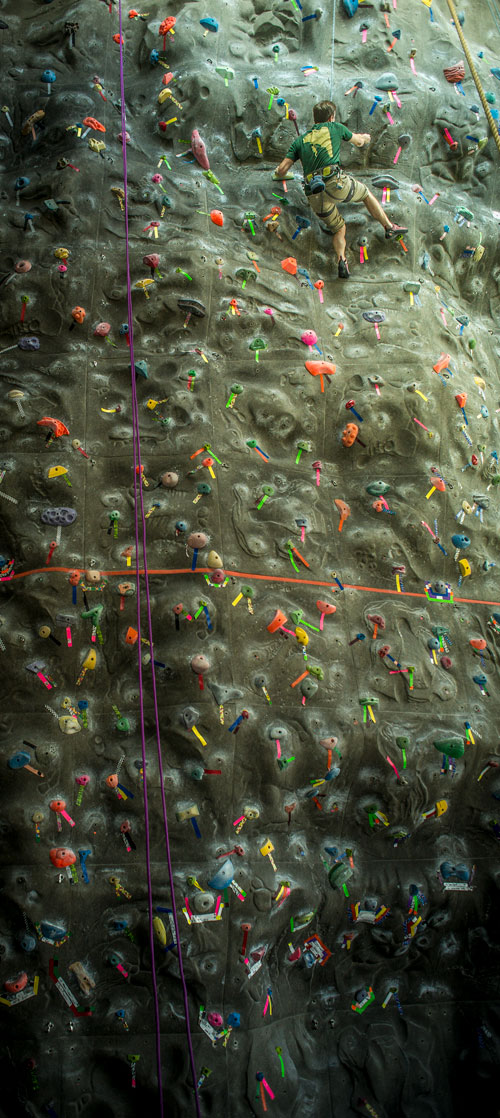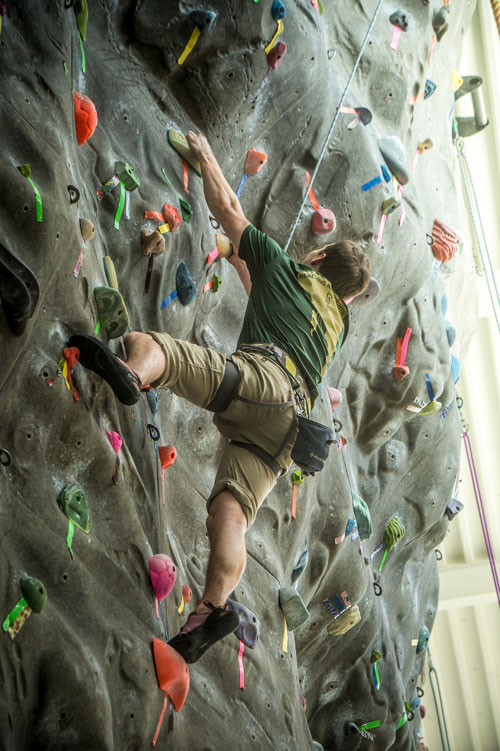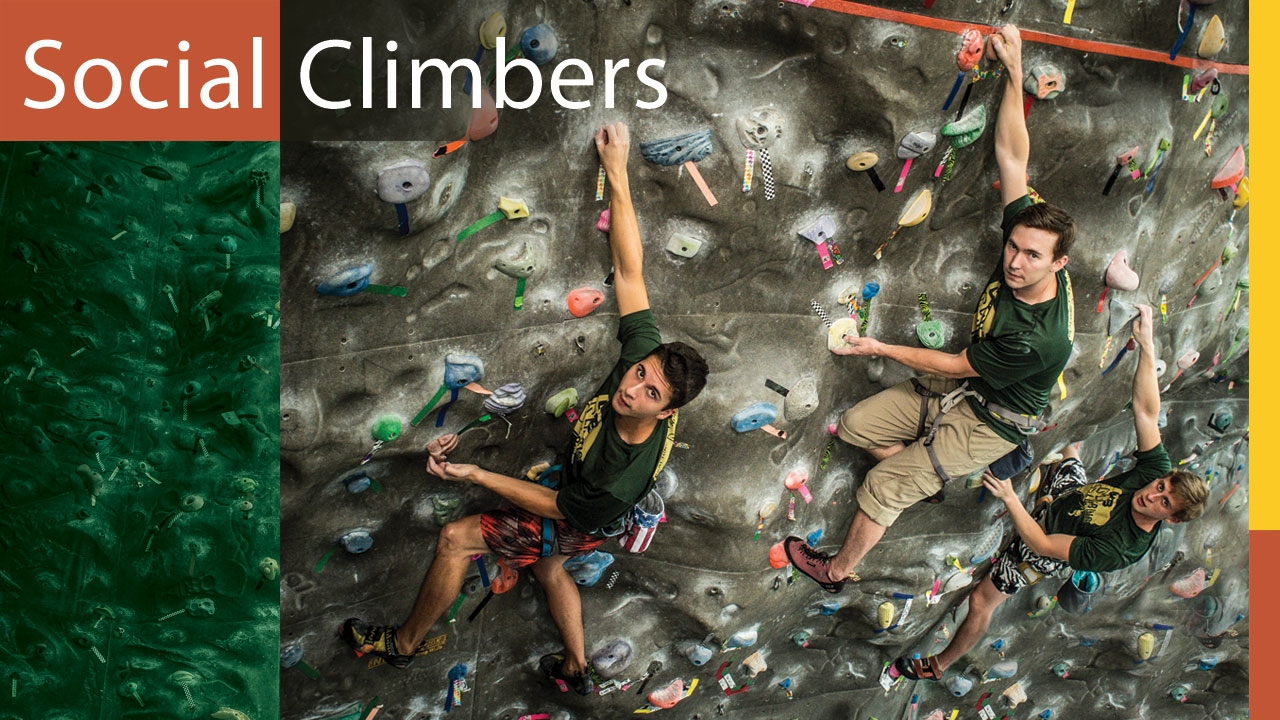(Above, left to right) Jordan Timothy, Drew Freeman, and Russ Timothy scale the 36-foot-high climbing wall at UAB's Campus Recreation Center.
Higher education has a different meaning for one group of students. Members of the fledgling UAB Climbing Club are aiming for new levels of achievement through their growing sport.

There are rarely any scheduled practices for the two-year-old organization. At best, a last-minute email will go out to the 30 to 40 club members asking anybody who is available to meet at the UAB Campus Recreation Center climbing wall. But when members do get together, they find themselves enjoying a supportive, positive atmosphere that they say carries over to their academic work.
“Climbing is a community-based sport,” says Jordan Timothy, a junior from Birmingham majoring in nursing who helped start the club a year after he began climbing as a UAB freshman. “Everybody encourages everybody, and it’s a positive environment to just improve yourself. That’s the ultimate goal, to improve yourself in climbing and in school and in life.”
The sport also takes the students far beyond campus. The club participates in official climbing competitions in places such as Auburn and Valdosta State in Georgia (and it hosts its own competition every February at the Campus Recreation Center). Members especially enjoy traveling to prime climbing sites throughout Alabama and the Southeast, where the rocky landscape offers a variety of challenges. “We want to get outside to amazing places where we can see amazing views and enjoy nature while pushing our limits,” Timothy says. “Everything we do indoors is training for that.”
Strength Isn’t Everything
Though it certainly helps to be physically fit, climbing is not all about pure strength. Balance, coordination, dexterity, and the ability to think ahead in order to choose the best path forward also are important.
“A lot of people have this misconception that if you can do a bunch of pull-ups, then you can climb. But that’s not the case,” says senior biology major Drew Freeman, from Moody, Ala., who began climbing last year. “It requires a lot of technique. You have to use your head. It’s not like climbing a ladder. There are different ways to go about climbing a technical, difficult route. So it’s very challenging physically and mentally, and that’s something I enjoy.”
Since strength is not the overriding factor in climbing, women are able to compete equally with men, and the competitions are not divided between genders. Russ Timothy, a graduate student majoring in public health (and Jordan Timothy’s older brother), said that in the three years he has been climbing, he has seen a number of women who are better at the sport than men.

“I see guys come in who are really muscular, who think they’re just going to do pull-ups straight up the wall. Then they’ll complete it one time and be spent,” Russ Timothy says. “Strength is part of it, but it’s more about understanding your body and your body’s movement. And I think women have a better understanding of that, because they haven’t been able to rely just on strength.”
In fact, strategy is probably more important than strength when it comes to climbing competitions. Handholds and footholds are placed in various locations along a climbing wall, creating different potential routes to the top. Each route is graded with a degree of difficulty and assigned a certain point value, with climbers receiving more points for harder routes. But a climber must make it all the way to the top to receive any points. So part of the strategy in the competition is deciding which routes are worth the risk and reward.
A Vertical Workout
For those who wonder if slowly climbing a wall can be considered a true athletic activity, Russ Timothy points to a research article he read as part of his public health graduate work. It details a recent study that found that people who climb on an intermediate level have an oxygen-consumption rate that is about 60 to 65 percent of someone running on a treadmill.
“So you’re getting a fantastic workout just climbing at an intermediate level, and newcomers can get to that level in a month,” he says. “Climbing is something almost anybody can excel in, and as you’re excelling, you can challenge yourself. For me, that challenge is an outlet, where I can blow off some steam in a positive, productive manner. And I’m sure that translates to a better overall learning experience at the university.”

Climbing Class
Members of the UAB Climbing Club offer five essential tips for beginners:
1. Keep your arms straight
You don’t carry bags of groceries with bent arms, so you shouldn’t climb with them either. When it comes to climbing, conserving energy is the name of the game, and keeping your arms straight as much as possible can be critical to your success.
2. Engage your core
Keeping your core muscles engaged helps in a variety of aspects, from staying close to the wall to being able to reach the next handhold. Although it appears that climbing would take an insane amount of upper-body strength, core strength actually is the most important aspect to effective climbing.
3. Use your toes
In order to take unnecessary weight off your shoulders, arms, and fingers, put as much weight on your feet and toes as you possibly can. And just when you think you have shifted enough weight on them, shift some more.
4. Plan ahead
Approach climbing as you would a game of chess. It is more efficient to plan out a particular sequence of moves beforehand than it is to blindly grab each and every hold in front of you. A good general rule: If you want to grab a hold with your left hand, stand off your left foot (and vice versa). Perhaps most important, rest and shake out your arms along the way to avoid tiring out.
5. Learn the lingo
Climbers seem to have created their own language, and it is important to understand it in order to climb safely and effectively. So be sure to learn terms such as “gaston” (a climbing grip using one hand with the thumb down and elbow out), “sloper” (a hold without much positive surface, comparable to palming a basketball), and “undercling” (a hold gripped with the palm of the hand facing upward).

• Learn more about student club sports at UAB and the amenities and programs offered by the Campus Recreation Center.


